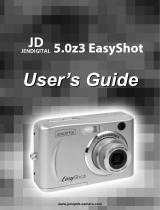
8
z
Do not allow the equipment to come into contact with, or become immersed in, water or
other liquids. Do not allow liquids to enter the interior. The camera has not been
waterproofed. If the exterior comes into contact with liquids or salt air, wipe it dry with a soft,
absorbent cloth. In the event that water or other foreign substances enter the interior,
immediately turn the camera's power off and remove the batteries or unplug the power cord
from the power outlet. Continued use of the equipment may result in fire or electrical shock.
Please consult your camera distributor or the closest Canon Customer Support Help Desk.
z
Do not use substances containing alcohol, benzene, thinners or other flammable
substances to clean or maintain the equipment.
The use of these substances may lead to fire.
z
Remove the power cord on a regular periodic basis and wipe away the dust and dirt
that collects on the plug, the exterior of the power outlet and the surrounding area. In
dusty, humid or greasy environments, the dust that collects around the plug over long periods
of time may become saturated with humidity and short-circuit, leading to fire.
z
Do not cut, damage, alter or place heavy items on the power cord. Any of these actions
may cause an electrical short circuit, which may lead to fire or electrical shock.
z
Do not handle the power cord if your hands are wet. Handling it with wet hands may lead
to electrical shock. When unplugging the cable, ensure that you hold the solid portion of the
plug. Pulling on the flexible portion of the cable may damage or exposure the wire and
insulation, creating the potential for fires or electrical shocks.
z
Use only recommended power accessories. Use of power sources not expressly
recommended for this equipment may lead to overheating, distortion of the equipment, fire,
electrical shock or other hazards.
z
Do not place the batteries near a heat source or expose them to direct flame or heat.
Neither should you immerse it in water. Such exposure may damage the battery and lead to
the leakage of corrosive liquids, fire, electrical shock, explosion or serious injury.
z
Do not attempt to disassemble, alter or apply heat to the batteries. There is serious risk of
injury due to an explosion. Immediately flush with water any area of the body, including the
eyes and mouth, or clothing that comes into contact with the inner contents of a battery.
z
Avoid dropping or subjecting the batteries to severe impacts that could damage the
casings. It could lead to leakage and injury.
z
Do not short-circuit the battery terminals with metallic objects, such as key holders. It
could lead to overheating, burns and other injuries.
z
Before you discard a battery, cover the terminals with tape or other insulators to
prevent direct contact with other objects. Contact with the metallic components of other
materials in waste containers may lead to fire or explosions.
z
Use only recommended batteries and accessories. Use of batteries not expressly
recommended for this equipment may cause explosions or leaks, resulting in fire, injury and
damage to the surroundings.





















